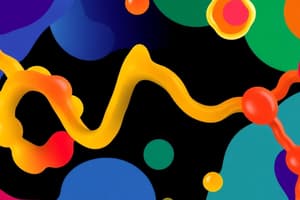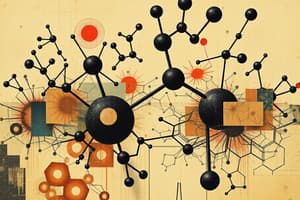Podcast
Questions and Answers
What is the general chemical formula for carbohydrates?
What is the general chemical formula for carbohydrates?
- C_n(H_2O)_{n+1}
- C_n(H_2O)_n-1
- C_n(H_2O)_n (correct)
- C_n(H_2O)_{n-2}
Which of the following is a mono saccharide?
Which of the following is a mono saccharide?
- Cellulose
- Starch
- Sucrose
- Glucose (correct)
What characteristic structure do carbohydrates typically have?
What characteristic structure do carbohydrates typically have?
- Ring-like formation
- Hexagonal shape (correct)
- Cylindrical structure
- Linear chain
What is a key function of carbohydrates in living organisms?
What is a key function of carbohydrates in living organisms?
Which of the following is NOT a component of carbohydrates?
Which of the following is NOT a component of carbohydrates?
What is the chemical formula for glucose?
What is the chemical formula for glucose?
Which polysaccharide is primarily used by plants for storage of glucose?
Which polysaccharide is primarily used by plants for storage of glucose?
What role does cellulose play in the plant structure?
What role does cellulose play in the plant structure?
How do animals utilize starch?
How do animals utilize starch?
Which of the following is NOT a carbohydrate?
Which of the following is NOT a carbohydrate?
What is the primary function of glycogen in animals?
What is the primary function of glycogen in animals?
Ribose, a carbohydrate, is best known as a component of which of the following?
Ribose, a carbohydrate, is best known as a component of which of the following?
Which carbohydrate cannot be broken down by most animals?
Which carbohydrate cannot be broken down by most animals?
Which part of a chemical formula represents the quantity of each type of atom in a molecule?
Which part of a chemical formula represents the quantity of each type of atom in a molecule?
What is represented by the symbol 'O' in the chemical formula O2?
What is represented by the symbol 'O' in the chemical formula O2?
Which of the following best describes the function of receptor proteins?
Which of the following best describes the function of receptor proteins?
What do antibodies bind to in the body?
What do antibodies bind to in the body?
What type of proteins allow certain molecules to pass through cell membranes?
What type of proteins allow certain molecules to pass through cell membranes?
The chemical formula for a simple carbohydrate typically includes which of the following elements?
The chemical formula for a simple carbohydrate typically includes which of the following elements?
What do chemical formulas utilize to communicate information about compounds?
What do chemical formulas utilize to communicate information about compounds?
The presence of a subscript in a chemical formula indicates what?
The presence of a subscript in a chemical formula indicates what?
Flashcards
Protein Function
Protein Function
Proteins perform various functions by binding to other molecules, like when enzymes bind to reactants to speed up reactions, antibodies bind to invaders, or transport proteins let specific molecules pass through cell membranes.
Receptor Protein
Receptor Protein
A protein found on cell membranes that binds to specific signal molecules, relaying information to the brain.
Olfactory Receptor Neuron
Olfactory Receptor Neuron
A type of cell responsible for our sense of smell, containing odor receptor proteins.
Odor Receptor Protein
Odor Receptor Protein
Signup and view all the flashcards
Chemical Formula
Chemical Formula
Signup and view all the flashcards
Element Symbol
Element Symbol
Signup and view all the flashcards
Subscript in a Chemical Formula
Subscript in a Chemical Formula
Signup and view all the flashcards
Parts of a Chemical Formula
Parts of a Chemical Formula
Signup and view all the flashcards
What is chitin?
What is chitin?
Signup and view all the flashcards
What are carbohydrates made of?
What are carbohydrates made of?
Signup and view all the flashcards
What is the general chemical formula for carbohydrates?
What is the general chemical formula for carbohydrates?
Signup and view all the flashcards
What is the shape of a glucose molecule?
What is the shape of a glucose molecule?
Signup and view all the flashcards
What atoms make up a glucose molecule?
What atoms make up a glucose molecule?
Signup and view all the flashcards
Carbohydrate Formula
Carbohydrate Formula
Signup and view all the flashcards
Glucose
Glucose
Signup and view all the flashcards
Starch
Starch
Signup and view all the flashcards
Cellulose
Cellulose
Signup and view all the flashcards
Glycogen
Glycogen
Signup and view all the flashcards
Monosaccharide
Monosaccharide
Signup and view all the flashcards
Polysaccharide
Polysaccharide
Signup and view all the flashcards
Dietary Fiber
Dietary Fiber
Signup and view all the flashcards
Study Notes
Module 1 Guided Notes
- The video provided goes over all concepts in Module 1.
- Quick Links are available at the bottom of each section. These links are helpful for easy navigation.
- Topics include Exploring Life, Chemistry of Life, Chemistry of Life (Honors), and Earth's Early Atmosphere.
- The first page of the Biology Notebook introduces macromolecules.
- Key organic macromolecules include carbohydrates, lipids, nucleic acids, and proteins.
- These molecules have common functions related to providing energy and the structure of living organisms.
- Page 2 discusses biological macromolecules and defines a monomer.
Biological Macromolecules
- A monomer is a molecule that can react with other molecules to form a larger polymer chain.
- Polymers are made of monomers.
- The four major macromolecules are carbohydrates, lipids, proteins, and nucleic acids.
- Each macromolecule has a different function in living organisms.
Carbohydrates
- Monosaccharides are the smallest type of carbohydrate molecule. Examples include glucose, galactose, and fructose.
- Disaccharides are formed by bonding two monosaccharides together. Examples include sucrose and lactose.
- Polysaccharides are formed by bonding numerous monosaccharides together. Examples include starch, cellulose, and glycogen.
- Carbohydrates provide energy to cells.
Lipids
- Lipids are a diverse group of molecules that are not characterized by repeating structural units (monomers).
- Three main categories of lipids are fats, phospholipids, and steroids.
- Lipids store energy in the body and provide insulation, protection, and cushion to organs
- Triglycerides, composed of one glycerol molecule combined with three fatty acid molecules, are examples of lipids.
Proteins
- Proteins are complex molecules made up of amino acid monomers.
- Proteins can have diverse functions in organisms, including hormones, structural components, enzymes, and antibodies.
- The specific order/arrangement of amino acids in a protein gives proteins their unique properties.
Nucleic Acids
- Nucleic acids are macromolecules that store and transmit genetic information.
- The two major types of nucleic acids are DNA (deoxyribonucleic acid) and RNA (ribonucleic acid).
- Nucleic acids are made up of nucleotide monomers.
- Each nucleotide monomer is composed of three parts: a nitrogenous base, a five-carbon sugar, and a phosphate group.
- The order of the nucleotides in nucleic acids determines the genetic code.
Studying That Suits You
Use AI to generate personalized quizzes and flashcards to suit your learning preferences.
Related Documents
Description
This quiz covers the key concepts from Module 1 of Biology, focusing on biological macromolecules such as carbohydrates, lipids, proteins, and nucleic acids. Understand their structures, functions, and the role of monomers and polymers in living organisms. Perfect for reinforcing your knowledge of life's chemistry and early atmospheric conditions.




